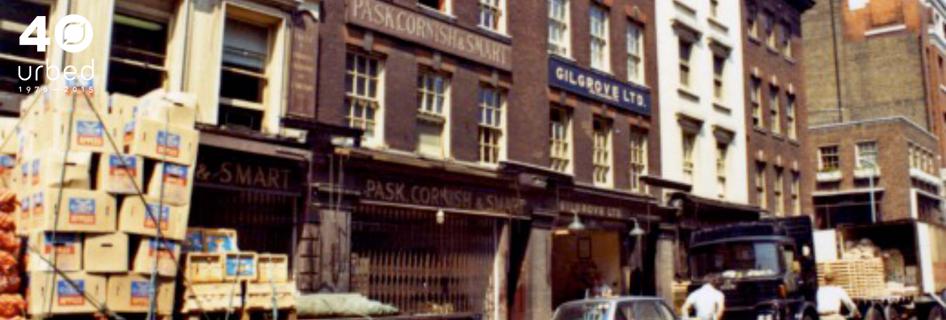The first regeneration area?

URBED40: Nicholas Falk from URBED on Vimeo.
URBED began in the 1970's when founder Nicholas Falk and some of his colleagues saw the potential for applying fresh thinking on ‘adaptive reuse’. They wanted to enable small enterprises to fill the gaps left by the collapse of larger companies in Covent Garden.
After the fruit and vegetable markets moved south of the river, the old buildings were acquired by the Greater London Council. Community opposition stopped the original proposals for new roads and a conference centre, the Government who listed some 270 buildings as well as designating Conservation Areas.
When the fruit and vegetable markets moved south of the river, the Greater London Council, initially with the two boroughs of Camden and Westminster, established the Covent Garden Planning Team. Deputy team leader, surveyor Tim Wacher, recalled a desolate time when there was no private funds for major property investment. However, this enabled creative people like architects to take over buildings and reanimate the area through their economic activity.
URBED40: Tim Wacher from URBED on Vimeo.
This economic reality chimed with the refurbishment philosophy of the Covent Garden Action Area Plan (1978). Community gardens took over derelict sites, and provided space for festivals. A very active community association helped shape a new comprehensive plan, and Covent Garden’s location on the Piccadilly Line made it effectively the first Transport Development Area. The only way shops could be attracted to take over the limited ground floor premises in the Central Market Building was to ensure they provided what no others did. The Covent Garden Area Trust took over buildings for a nominal rent that are let as market spaces, and help fund community facilities.
URBED organised the exhibition Covent Garden Can Make It in 1976, set up a Space Exchange to help businesses get and sublet small spaces, and started up the first programmes to train and support entrepreneurs. We also used action research to influence government policy, for example through my Fabian Pamphlet Think Small: Enterprise and the Economy. We encouraged embryonic developers such as Gillian Harwood and Eric Reynolds by sharing experience. Licences on ‘easy in easy out’ terms were the key. Firms such as Rock Townsend developed 5 Dryden Street as a working community, where young architects like Alan Stones got a break. But as demand and rental values rose, so we and other pioneers had to move out.
URBED40: Alan Stone from URBED on Vimeo.
City and cultural expert Charles Landry, who was running Comedia at the time, gave a keynote and acknowledged that URBED have moved from the rearguard to the vanguard of a creative movement to adapt old buildings to new uses.
URBED40: Charles Landry from URBED on Vimeo.
The idea of heritage value has taken off around the world, and Covent Garden has become iconic. Heritage and creativity go together, and while creativity is renewable, heritage is not. New ideas flourish in old places that are flexible and easy to adapt, and these areas then become popular places to visit, and values escalate.
URBED40: Liane Hartley from URBED on Vimeo.
URBED’s distinctive approach was to combine action research with experimental initiatives or taking risks. As Liane Hartley, founder of new creative enterprise MEND, remarked at the end, regeneration is about ‘releasing the genius of a particular place’, which is all about relationships. This first event certainly allowed relationships to be renewed, and even stimulated some new ones.




